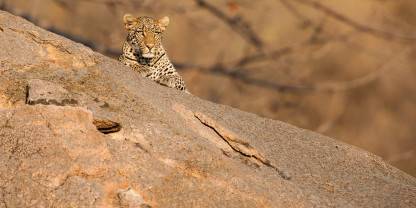Average Expert Rating
Rating Breakdown
Write a User ReviewInto the Wild
While we easily spotted numerous giraffe, zebra, kudu, impala and elephant, we struggled to spy any lions in spite of the fact that the park supports a very healthy lion population. When we finally happened across two lone males, our driver managed to scare them off before we’d even raised our cameras. He also managed to irritate a very large bull elephant by barrelling through the middle of its herd. In all my years of game
Read more
viewing, I’ve never actually seen a riled-up elephant charge at full speed before, nor seen a driver that scared. Word to the wise: make sure you hire an expert safari driver if you’re taking your own vehicle.The Park that Time Forgot
What’s more, this is serious lion country. When I stayed with Chris Fox in 2008 he knew of 185 lions within 20 miles of his camp on the Mwagusi Sand River. I saw some of them, including an awesome coalition of five nomadic males hell-bent on taking over the local pride. Much of the park is a tsetse-infested
Read more
wilderness of impenetrable miombo woodland; but the north around Mwagusi and where the great Ruaha Sand River lies is much more open and accessible, with a good chance of finding leopard, cheetah - even wild dogs.Good variety of wildlife in formidable landscapes
Read more
and after the rainy seasons, creating splashes of green in the otherwise dry and brittle environment. My other Ruaha highlight is the tremendous landscapes. Given that most of the park is on the top of a 900m plateau, the ripples of broken hills and small mountains make a wonderful frame for the river valleys, miombo woodlands and open grassland.Elephants & Baobabs
Ruaha is notable both for its unique wilderness scenery – rugged, arid vistas punctuated by massive baobabs and backed by purple-hued hills – and for its great variety of wildlife, which includes a mix of East and southern African species.
The peak months for visiting are July through October, when wildlife spotting is highly rewarding. Ruaha is particularly known for its large numbers of elephants. Other draws are wild dogs (although these can be elusive – I have yet to spot any here), buffaloes, and both roan and sable antelopes. The Great Ruaha River, with its rocky outcrops, slumbering hippos, lazy crocodiles and wealth of birds, is wonderful.
Ruaha is easily accessed by road from the gateway town of Iringa, or by flight, and its rehabilitated bandas and riverside camping are a treat for budget travellers. Wildlife can be difficult to spot off-season (particularly March through May), so it’s worth trying to plan your visit for the drier months.
Diversity in Ruaha National Park
Large elephant herds gather in the riverbeds to dig for water. When the giants have moved on, baboons and other opportunistic animals use these holes to quench their thirst as well. Ruaha is known for its large lion prides. On our last visit we spent a lot of time with a pride counting more than 25, including two sets of small- and medium-sized cubs. To feed so many tummies, the lions must hunt regularly, and you might be lucky to see some action. Leopards are often seen on the rocky cliffs where they feed on hyrax. But I couldn’t believe my luck when we found
Read more
one of these agile cats lazing on a branch of a baobab tree. It certainly made for an iconic image. Big cats aside, the most highly prized predator in Ruaha is the African wild dog. Denning season (June to August) is the best time to look for them.There is no other park in Tanzania that offers such an extensive variety in antelope, including some of the most impressive species. Greater kudu is so common here, we became blasé about seeing them. Lesser kudu is notoriously skittish, but we saw several darting off in the bush as well. If you know where to look, you should find roan and sable antelope too. It takes some dedication to track down the latter though, as they tend to stick to tsetse-fly-infested mopane woodland areas.
Baobabs & Elephants
Ruaha National Park is part of the southern safari circuit in Tanzania, and some safari itineraries combine Ruaha with Nyerere (formerly Selous). Although it is Tanzania’s second-largest park, it is little visited, due to its remoteness, and so you get a real sense of wilderness staying here. It is stunningly beautiful, with the Ruaha River meandering through, speckled with hippos and crocs. My abiding memory is the huge baobabs, dwarfing the herds of elephants. We failed to see lions despite other travellers’ tales of the big prides they’d seen. Ruaha has fantastic birding, with some real specials, such as the black-collared lovebird, Eleonora’s falcon and the localised Tanzanian red-billed hornbill. The best time to go is July to September during the dry season.

